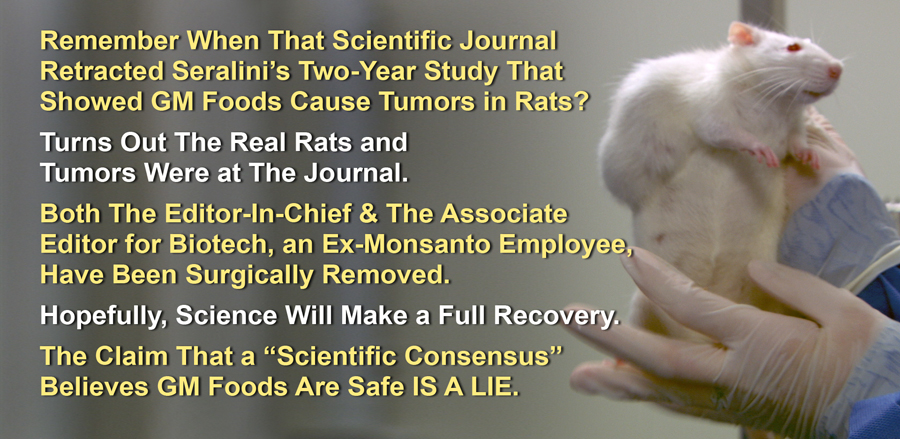Critical changes have this year been made at the journal, Food and Chemical Toxicolgy, from which the Editor-in-Chief A. Wallace Hayes retracted the important paper by the Seralini team. The Editorial Board of the journal [19] now has a new Editor-in-Chief, José L. Domingo, who has published papers showing that safety of GM crops is not an established fact; and the Editorial Board no longer includes Richard Goodman, the ex-Monsanto employee who became Associate Editor for Biotechnology not long before the Seralini paper was retracted.
http://www.sgr.org.uk/resources/scientific-publication-peril-seralini-affair
The ‘Séralini affair’ illustrates the pervasive influence and power of major corporations over biotechnology publications and research. Evidence of harm to health caused by products during testing by companies can be hidden under ‘commercial confidentiality’ or by a poor experimental design. A once-respected journal can no longer be relied upon to be objective, with studies showing harm from GM crops rejected without good reason, while studies finding safety in flawed experiments are published. It is difficult not to conclude that science is being corrupted to suppress legitimate questions about the safety of GM crop technology.
Re-publication in another journal
In June 2014, the Séralini et al.paper was re-published with open access in the Springer Group journal Environmental Sciences Europe. Again, there was an immediate outcry by GM supporters. In addition, the researchers have published for open access all their raw data — something the GM companies have always refused to do.
The Height of Past Bias: A “Rigged” paper from the GM industry stays, while Seralini’s gets retracted.
The flawed process by which FCT has selected some papers for publication is emphasised by its acceptance of a new study [16] from scientists working in the GM industry. A rat-feeding trial of a GM canola, a type of oilseed rape, by six DuPont scientists found the GM crop to be as safe as non-GM varieties. This conclusion has been challenged by the Seralini team in a Letter-to-the-Editor of FCT [17], on the grounds that (a) having analysed the diet (obtained from the named company), they found that the diets of the control rats contained large proportions of two GM maizes and also glyphosate residue; (b) the usual 3-month duration was too short to show long-term effects; and (c) additional ‘control’ groups fed ‘reference canola varieties’ were used. The same strain of rat was used as by the Seralini researchers with 12 rats per sex per group, compared with 10 by the Seralini team. Three rats died or had to be put down during the study. As usual in industry studies, statistical differences were regarded as being “of no biological relevance”. The results were said to “support the conclusion” that the canola is safe. To add further insult to injury, the DuPont scientists declared at the end of the paper that they had “no conflicts of interest”. Moreover, the lead author is a Managing Editor of the journal. [18]


